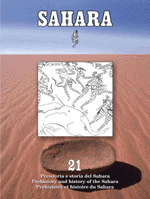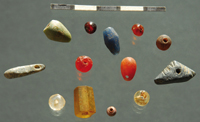| Contents
Abstracts |
Abstracts of Sahara volume 21
(published July 2010)
|

|
Steven E. Sidebotham and Iwona Zych
Berenike: Archaeological fieldwork at a Ptolemaic-Roman port on the Red Sea coast of Egypt 2008-2010
ABSTRACT
Fieldwork expanded knowledge about Berenike’s contacts with other areas of the Red Sea-Indian Ocean including religious, industrial, consumer and maritime practices and early Roman-era ship building methods. A total station survey precisely located all trenches excavated since 1994. Geophysical surveying provided new data on subterranean features. Excavation of four dog skeletons suggested a pet cemetery. Approximately 240 1st century AD ostraca preserved details about Roman military supply of fresh water to Berenike. Excavations recovered Pre-Islamic South Arabian graffiti, which added a twelfth ancient language documented from the site. Imported Boswellia wood indicated the presence of frankincense. By the 1st- 2nd centuries AD the harbor had been engulfed in sand and became trash dumps and industrial areas. Ropes, a bollard and ship timbers signaled some continued maritime activity here. Geophysical data and excavation suggested that a late Roman-era shrine had been constructed on an island or dredge heap. The temple contained a dedication to Isis, Tyche and perhaps Serapis, miniature temple pools, altars, an incense burner, a patera/phiale with remains of a tripod, wooden bowls and cowry shells. Ostrich eggshells preserved magic/religious incantations. Painted and incised pentagrams were likely symbols of the Dog Star, associated with the Egyptian New Year, the start of the Inundation season and with Isis. Trash dumps provided evidence of small scale industrial activity in wood, turtle shell, animal bone and leather in the late Roman period.
|
Malika Hachid, Jean-Loïc Le Quellec, Safia Agsous, Ali Amara, Lucile Beck, Frédérique Duquesnoy, Michel Grenet, Abdelkader Heddouche, Evelyne Kaltnecker, Norbert Mercier, Souhila Merzoug, Anita Quiles, Hocine Sahnoun, Hélène Valladas, Daniel Vigears, avec la collaboration de C. Gauthier et Frank Bassinot
Premiers résultats du projet algéro-français de datation directe et indirecte des images rupestres dans la Tasili-n-Ajjer
ABSTRACT
The first expedition by the Algerian-French project aimed at establishing the age of Saharan rock art travelled to Sefar. It was able not only to discover a large number of new paintings attributable to the “Roundhead” style, but also to make some observations about the environment of these works of art, and in particular about some major changes in ground level. Traces of the ancient floors on which the artists walked were found. Analyses are now being carried out in order to date these floors, which should make it possible to specify the period when the paintings were made.
|
|
Top

|
Savino di Lernia, Marina Gallinaro and Andrea Zerboni
UNESCO World Heritage Site vandalised. Report on damages to Acacus rock art (SW Libya)
ABSTRACT
The recent vandalism of some paintings and engravings in the Acacus Mts. (SW Libya, central Sahara), a UNESCO World Heritage site since 1985, has been the subject of field and laboratory assessment by the Libyan Department of Archaeology (DoA) and the Italian-Libyan Archaeological Mission (Sapienza University of Rome). The damage is extremely severe, and it is unlikely that the paintings can be successfully restored, whereas it is hoped that some engravings can be cleaned. In this paper, we suggest that this umpteenth attack on Libya’s cultural heritage should be seen in a broader perspective: the Libyan authorities, and researchers and scholars working in the area should renew their view of these delicate contexts. Management tools and safeguard approaches should probably be reconsidered, in order to guarantee a better protection of the area.
|
|
Mohssine El Graoui, Youssef Bokbot, Högne Jungner et Susan Searight-Martinet
Datation radiocarbone sur des ossements mis au jour dans un tumulus à l’Adrar n’Zerzem, Oued Eç-çayad, région de Taghjijt (Sud marocain)
ABSTRACT
Dated tumuli are very rare in Morocco. Three tumuli from the Adrar n’Zerzem (south Morocco) necropolis have been excavated and the human bones from tumulus no. 2 have been radiocarbon dated with the AMS technique.
|
|
Top
|
Alec Campbell and David Coulson
Big Hippo Site, Oued Afar, Algeria
ABSTRACT
We recorded 22 engravings of hippopotami, what may be a ritual hippo hunt, six saurians and three penises amongst some 50 engravings on a river pavement. The position of the hippo engravings suggests regular immersion and a possible rainmaking site. Penises and saurians could indicate performance of circumcision at the site. We tentatively speculate on the possibilities of hippo spirituality shifting east to the Nile Valley and circumcision as part of male initiation spreading east and south to the sub-continent.
|
|
Top
|
Victoria Waldock
The Taleschout Hippos: An enigmatic site in the Messak Settafet, southwest Libya
ABSTRACT
During a recent research expedition in the Messak Settafet, our team recorded an unusual and impressive rock art site in the Wadi Taleschout. Stretching for 35 metres along a section of the wadi wall, is a string of about 15 enigmatic hippo engravings. The hippos are striking for their size, ranging from roughly 100 cm to 375 cm in length. More striking perhaps, is the fact that the engravings appear in varying stages of completion. Some are scarcely sketched outlines, others have small sections that are exquisitely detailed and carefully polished, while still others appear to have been re-worked repeatedly. Was the site perhaps abandoned and then re-activated later? And what might have inspired the image-makers to create such a dramatic assemblage of hippos? This article provides an in-depth description of the Taleschout Hippo Site and offers some suggestions as to the motivation for the creation of ‘aggregates of hippos’. Positing the issues explored at the Hippo Site as reflective of broader concerns, this paper examines the changing relationship between humans, their environment and their spiritual world in the mid-Holocene.
|
|
Giancarlo Negro and Massimo Cammelli
The flint quarries of Wadi El Sheikh (Eastern Desert of Egypt)
ABSTRACT
Halfway between Beni Suef and El-Minya, Wadi El Sheikh is an eastern tributary of the Nile, rarely traveled by groups of nomads and more often by weekend motorcyclists or bulldozers gathering limestone for current building purposes. Nowadays, few people are aware that the ground shows evidence of ancient mine workings. In this immense area in fact, miners have been quarrying chert and manufacturing raw elements for millennia. Since late prehistory and also during the Old and Middle Kingdoms, Wadi El Sheikh was one of the most important flint-stone mining areas. Some archeological investigations were carried out by H.W. Seton-Karr in the late 19th century and very few surveys have been conducted in more recent times. In the last few years and early in 2009, the authors had the chance to visit the area and would like to prompt the competent authorities to take the necessary steps in order to guarantee the safeguard of this invaluable archaeological site.
|
|
Top
|
Azhari Mustafa Sadig
Neolithic Settlement Patterns and Cultural Sequence of Nubia (Northern Sudan)
ABSTRACT
This paper investigates the changes in settlement patterns characteristic of Neolithic societies in Nubia from the 6th to the late 4th millennium BC. The available information on the distribution of the Neolithic sites from this region is used to present the structure of settlement. The paper also discusses in brief the chronology and the social aspects of the Neolithic in the region. The paper concludes that the 6th millennium witnessed major changes in settlement patterns. Early 6th millennium sites throughout Lower Nubia ranged from ca. 20 to 4,200 sq. m in size, and many of these small sites ended by 3000 B.C. The second change in settlement patterns happened at the end of the 6th millennium. By 5000 B.C., the number of sites in Dongola region in Upper Nubia reflects a quite intensive occupation throughout the area.
|
|
Top
|
Alain Rodrigue
Le domaine rupestre de Taghijijt (Maroc)
ABSTRACT
The Taghjijt rock art area, in southern Morocco, some sixty kilometres east of Fam el Hisn, has been known for more than forty years. Although it can be considered as one of the most important assemblages of engraving sites in this part of the country, Taghjijt has been the subject of only two evaluation campaigns. Without challenging the level of the former works, we resume the method of the inventory of the seven main sites in the maader of Tanzirt, dealing with one station after another. This allows a better appreciation of the distribution of the engravings and some new documents are also published. A selection of drawings suggests the rock art atmosphere of the Anti-Atlas range of Morocco.
|
|
|

https://www.saharajournal.com
e-mail: reception@saharajournal.com
Last update Monday, September 2, 2013
|
|
|

